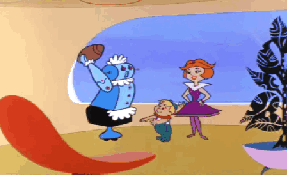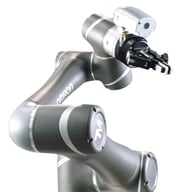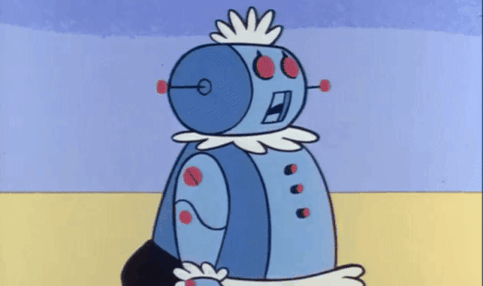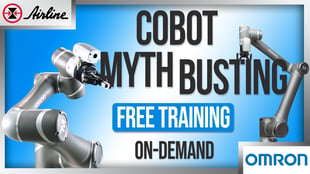
Do you remember Rosie, the helpful and friendly robot from The Jetsons cartoon? If you do, you know highly interactive and collaborative robots (or cobots) existed in science fiction long before the supporting technology was available. Today's cobots may not be on Rosie's level just yet, but we may be closer than you think to interact with cobots in everyday life!
All robots rely on human interaction to function, even if it's just pressing a button to start. So what labels a robot as a cobot, or collaborative robot? What does working alongside cobots look like today? And how can all this be safe? Let's dive into it all in this week's Technically Speaking!
Jump to a section:
Cobot Origins | What Makes a Robot Collaborative? | Cobot Design Differences | Safety Measures | Cobot Standards | The Future for Collaborative Robot Use | Summary
Collaborative Robot Origins
The technology for industrial collaborative robots began in the early 1990s. General Motors gained notoriety during this period for their Intelligent Assist Device (IAD) development efforts. IADs main design helped workers lift and position heavy payloads, improve productivity, reduce repetitive injuries, and boost morale. Since then, many companies and robot manufacturers have sought ways for industrial robots to work beyond the bounds of mechanical safety barriers and assist their human counterparts safely.
What Makes a Robot Collaborative?
 A traditional industrial robot—be it a SCARA, Cartesian, six-axis, or another type— operates utterly unaware of its surroundings. Its singular focus is the task it's programmed to perform. As a result, humans risk injury if they enter the robot's work cell without taking steps to stop the robot's motion and ensure its safe state.
A traditional industrial robot—be it a SCARA, Cartesian, six-axis, or another type— operates utterly unaware of its surroundings. Its singular focus is the task it's programmed to perform. As a result, humans risk injury if they enter the robot's work cell without taking steps to stop the robot's motion and ensure its safe state.
A cobot's primary design is to safely and productively co-exist and interact with humans in overlapping workspaces. The capacity for this interaction is also known as Human-Robot Collaboration or Human-Robot Interaction. Evolutions in sensor technology, software, safety, and robot-control systems now enable collaborative robots to take their place on the factory floor and physically interact with workers without the mechanical precautions and safeguards that prevent most robots from operating in open work environments.
Cobot Design Differences
While other robots are programmed simply for functionality and speed, collaborative robots are designed to have a much greater awareness, sensitivity, and responsiveness to their surroundings. A cobot's movements can even sync with the actions of humans working concurrently in a shared workspace. Cobots are also designed to be easier to program than traditional robots. When your coworker needs to perform a new task, you must be able to quickly and easily teach its functions while on-the-job (and without an engineering degree!).
|
Collaborative Robot Safety Measures
All of a cobot's interactions can be done safely alongside humans by applying limits to the cobot's speed, power, and force-generating capabilities. The more a robot may interact with a human, the more restricted it can be, although you should still carefully maintain minimum safe distances at all times.
A cobot that employs power and force-limiting capabilities comes closest to the true definition of a collaborative robot capable of operating completely unconstrained. In addition, with safety in mind, collaborative robots are designed to not have pinch points, sharp edges, or appendages that might inadvertently come into contact with a person. These design advancements further differentiate cobots from traditional robots.
Collaborative Robot Safety Standards
 In December 2016, the Robotics Industries Association (RIA) introduced TR R15.606-2016, which provides safety guidelines for using collaborative robots in the workplace. Hazard identification and risk assessments (learn more from MPSA) are essential for businesses to meet these guidelines before commissioning a collaborative robot.
In December 2016, the Robotics Industries Association (RIA) introduced TR R15.606-2016, which provides safety guidelines for using collaborative robots in the workplace. Hazard identification and risk assessments (learn more from MPSA) are essential for businesses to meet these guidelines before commissioning a collaborative robot.
In addition, the robot integrator must comply with existing safety standards, such as ANSI/RIA R15.06-2012, to ensure the safety of those working near collaborative robots. Safety measures and devices are also required if unauthorized individuals unfamiliar with the robot's movements must engage with the robot.
Learn more about cobot safetyWith the increasing popularity of collaborative robots (cobots), Airline and Omron noticed a gap between people’s assumptions about cobot safety and the realities of cobot safety. This article sets the record straight. |
The Future of Collaborative Robot Use
In the Industry
Collaborative robots are increasingly used in manufacturing environments, and their versatility makes them suitable for almost any task, including:
• Packaging
• Pick and place
• Assembly
• Machine tending
• Gluiing
• Quality Assurance
• Palleting
• Screw driving
• Intralogistics, and more
In the Classroom

Collaborative robots are also being introduced in the classroom to many students studying STEM applications.
In 2021, Airline worked on a state grant for robotic automation of a lab through York College and MRG Labs, This supplies students like Mikaela Domingo (pictured) the ability to program and use an Omron TM Collaborative Robot in their daily activities. With the cobot, student interns participating in the project have assistance in their tasks and can also free themselves from mundane and repetitive assignments in a lab. This collaboration gives new opportunities for students to find solutions in lab and manufacturing environments through the use of cobots.
Learn more in our article: Cobots in the Classroom: The York College Story
Summary
Like their industrial robot counterparts, collaborative robots are most helpful in performing tasks involving repetition, precision, danger, or heavy lifting. However, cobots can assist humans in these tasks in an interactive way free of machine safeguarding while still being completely safe, enabling seamless interactions, leaving human coworkers to focus on more complex tasks and avoid repetitive motion and overexertion injuries.
Work environments that can seamlessly integrate robot and worker interactions will undoubtedly lead to greater efficiencies. With the addition of the collaborative robot, it is easy to envision humans and cobots working side by side to pursue shared goals and objectives.
Rosie should be proud of the incredible value real-life cobots can provide!

Resources & Information
- Learn more about Omron Robotics
- Omron Robotics Landing Page
- Shop Robotics
- Shop the Omron TM Collaborative Robot
- Download the Omron TM Collaborative Robot Data Sheet
- Download the Omron TM Collaborative Robot Catalog
- Cobots in the Classroom
Related Videos
Meet Omron's Collaborative Robot
Puppy vs. Collaborative Robot SHOWDOWN 🐶🤖 WHO Can Learn a New Trick Faster?
Omron TM Collaborative Robot | Overview and Programming Demo
Contact Us!













Leave Comment